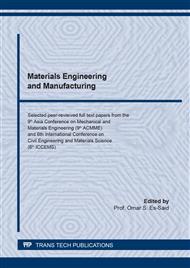[1]
T. Wang, O. Menshykov, M. Menshykova and I. Guz: Modelling and optimal design of thick-walled composite pipes under in-service conditions, IOP Conference Series: Materials Science and Engineering, Vol. 936 (2020), p.012046.
DOI: 10.1088/1757-899x/936/1/012046
Google Scholar
[2]
I.A. Guz, M. Menshykova and J.K. Paik: Thick-walled composite tubes for offshore applications: an example of stress and failure analysis for filament-wound multi-layered pipes, Ships and Offshore Structures, Vol. 12 (2017), pp.304-322.
DOI: 10.1080/17445302.2015.1067019
Google Scholar
[3]
J. Xing, P. Geng and T. Yang: Stress and deformation of multiple winding angle hybrid filament-wound thick cylinder under axial loading and internal and external pressure, Composite Structures, Vol. 131 (2015), pp.868-877.
DOI: 10.1016/j.compstruct.2015.05.036
Google Scholar
[4]
M. Menshykova and I.A. Guz: Stress analysis of layered thick-walled composite pipes subjected to bending loading, International Journal of Mechanical Sciences, Vol. 88 (2014), pp.289-299.
DOI: 10.1016/j.ijmecsci.2014.05.012
Google Scholar
[5]
K. Cox, M. Menshykova, O. Menshykov and I. Guz: Analysis of flexible composites for coiled tubing applications, Composite Structures, Vol. 225 (2019), p.111118.
DOI: 10.1016/j.compstruct.2019.111118
Google Scholar
[6]
C. Zhang, R. Chang and A. Li: Novel two-level strategy to exactly solve multilayer composite cantilever tubes of cylindrically orthotropic materials, Composite Structures, Vol. 237 (2020), p.111866.
DOI: 10.1016/j.compstruct.2020.111866
Google Scholar
[7]
S. Misri, S.M. Sapuan, Z. Leman and M.R. Ishak: Torsional behaviour of filament wound kenaf yarn fibre reinforced unsaturated polyester composite hollow shafts, Materials & Design (1980–2015), Vol. 65 (2015), pp.953-960.
DOI: 10.1016/j.matdes.2014.09.073
Google Scholar
[8]
P. Stedile Filho, J.H.S Almeida and S.C. Amico: Carbon/epoxy filament wound composite drive shafts under torsion and compression, Journal of Composite Materials, Vol. 52 (2018), pp.1103-1111.
DOI: 10.1177/0021998317722043
Google Scholar
[9]
S.A. Mutasher: Prediction of the torsional strength of the hybrid aluminum/composite drive shaft, Materials & Design, Vol. 30 (2009), pp.215-220.
DOI: 10.1016/j.matdes.2008.05.024
Google Scholar
[10]
M. Kawai and S. Saito: Off-axis strength differential effects in unidirectional carbon/epoxy laminates at different strain rates and predictions of associated failure envelopes, Composites Part A: Applied Science and Manufacturing, Vol. 40 (2009), pp.1632-1649.
DOI: 10.1016/j.compositesa.2009.08.007
Google Scholar
[11]
M.V. Menshykova, O.V. Menshykov and I.A. Guz: An iterative BEM for the dynamic analysis of interface crack contact problems, Engineering Analysis with Boundary Elements, Vol. 35 (2011), pp.735-749.
DOI: 10.1016/j.enganabound.2010.12.005
Google Scholar


